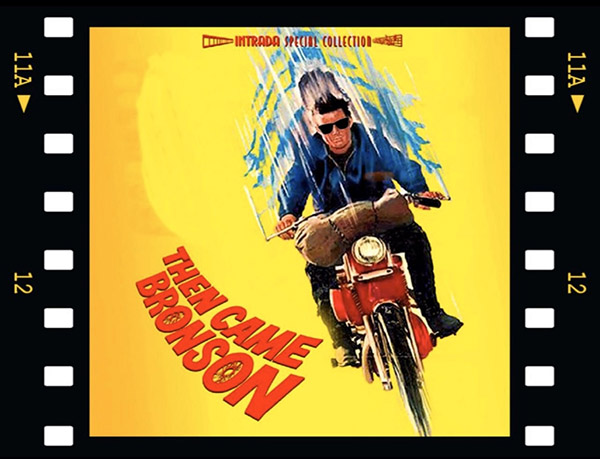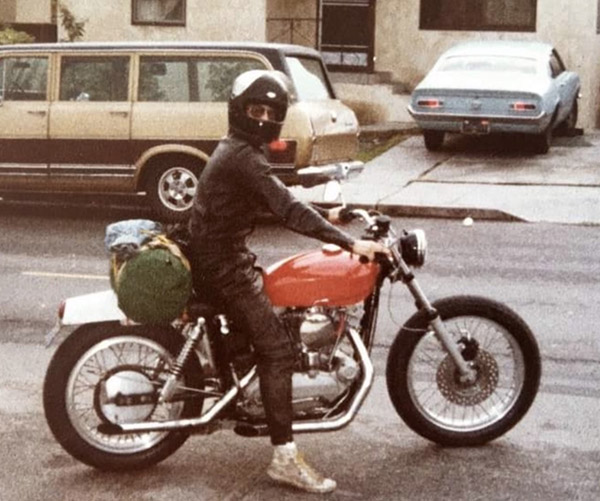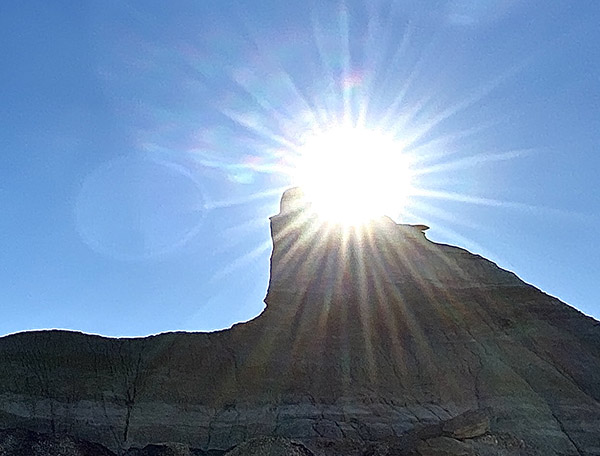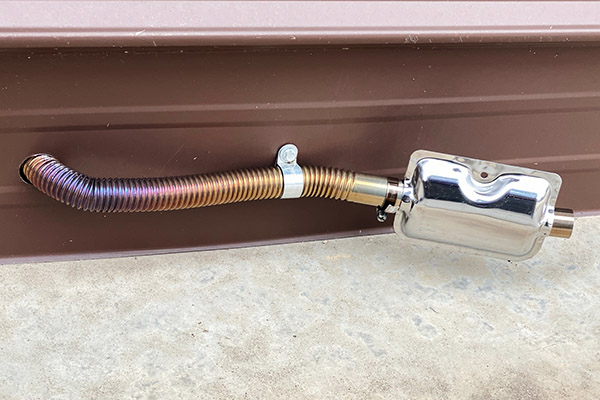By Joe Gresh
I recently hurt my back feeding a 5-pound log into our wood stove. It’s been cold here in New Mexico, like in the 20’s at night. In the morning CT likes to get a roaring fire going to take the chill off the Carriage House’s unheated living room. The place is only 600 square feet so burning two or three logs makes it nice and toasty for her as she gets ready to go to work. When I finally roll out of bed I enjoy the heat also.
It’s strange to me that I can lift thousands of pounds of concrete without any pain to speak of yet the slightest movement can cause such a heavy thud to my lower back. I was just doing my part to make CT’s life even more comfortable when I opened the stove door, reached in with the log and cried out with pain. It was pretty bad. I couldn’t walk or stand up. I doped myself up on Wal-Mart’s finest stomach-bleeding, generic painkillers and settled in for a day of agony.
One thing I’ve learned about my back in the 65 years I’ve owned it is that rest is no way to improve a sore back. To sit down or lie in bed may feel better at the moment but in the end it just makes it worse. You have to keep moving. Obviously concrete work was out of the question so after the pain killers kicked in I walked (slowly) up to the shed to tinker around with the Husqvarna.
The Carrizozo Mudchuckers, who I ride with on occasion, are transitioning to harder core off road motorcycles. One guy has a Honda XR350. Mudchucker Mike bought a Husaberg 400, which is basically a dirt bike with the bare minimum of lighting necessary to be street-legal. I figured if I was going to keep up with these full-on offroad bikes I needed to make the Husqvarna 510 less of a Supermotard and more like Husqvarna’s TE-type dirt bikes.

Even though it looks like a dirt bike the 510 Husky is rigged to be a street bike. It has slightly shorter suspension, wide, 17’ radial tires with a giant front disc brake that I am madly in love with. The bike can stop on a dime and return a dollar three eighty-five. You actually earn money every time you squeeze the front brake lever. Unfortunately that tiny doughnut front wheel is not so good in the dirt. Tire choices for serious off work are limited and I’ve found nothing that works even ok off road. In mud the tire loads up after just a few revolutions turning into a greasy slick. In sand it steers poorly and doesn’t dig in around corners well. About the only place it’s good is on ½ mile flat tracks.
I was pretty sure a 21-inch front wheel would work much better. There’s a reason almost every dirt bike comes with a 21-inch front wheel. First, you’ve got hundreds of tire choices. Every conceivable condition has a tire specifically designed for it. To me, a skinny 21-inch cuts through mud better and loads up less allowing more steering control. The same can be said for sandy conditions. The larger diameter wheel rolls over obstacles easier due to the less abrupt approach angle. Plus, a 21-inch front wheel just looks better on a dirt bike.
I bought a slightly bent, $100 21-inch TE Husqvarna front wheel complete from eBay a few years ago. It was one of those modifications I planned on doing and since my back was shot I figured, what better time? It’s good light duty work. The rim was pretty wobbly so I removed a bunch of spoke nipples and pounded on the thing with a sledgehammer. Those aluminum rims are stronger that you think. I managed to get the wheel a little straighter but it really needs a new rim.
The eBay TE hub looked exactly like the original hub on the 510 except the SMR axle was larger than the TE axle, probably due to the higher stresses asphalt puts on the long forks. The larger axle meant I had to swap the 17-inch wheel bearings into the 21-inch wheel hub. Along with the larger axle the SMR has a larger disc rotor so that part had to be swapped over to the 21-inch wheel also.

The disc rotor is secured to the hub by allen-head bolts and they were tight. I tried heat, I tried penetrating oil, and I tried an impact tool. Through all this monkey motion I managed to round out the hex in the rotor bolts and several allen sockets. Too easily, I fell back on my old reliable cold chisel to remove the rotor bolts. Needless to say the bolt are now unusable.

The old (smaller) rotor came off easily on the 21-inch wheel and it was then that I realized the TE rotor bolts were smaller. In fact, the TE rotor mounting-bosses were smaller than the SMR mounting bosses. The rotor bolt-hole centers were the same and the SMR rotor mated up to the TE hub. I used the smaller TE bolts as they were a countersunk type and self centered in the larger SMR rotor holes. I made a mental note to add spacers or drill and tap the TE hub for the larger SMR bolts at some undefined later date. Shoddy as it was, the 21-inch front wheel bolted into the SMR forks and seemed to fit perfectly. I spun the wheel: it was bent but not that bent.
The original 17-inch rim is so small and the disc rotor is so large that you have to remove the caliper to remove the wheel from the forks. And this is when things started to go pear-shaped. I bolted the caliper on and gave the 21-incher a spin. It didn’t spin well at all.
The spokes on the Husky SMR510 were always close to the caliper even with the stock setup. What I didn’t foresee was that the smaller wheel located the caliper very near the rim where the spokes were centered and farthest away from the spokes. With the 21-incher’s less-steep spoke angle and the caliper having moved closer to the hub in relation to the rim edge the spokes hit the caliper. They weren’t hitting hard, mind you, the wheel still spun. But they were hitting.


Not one to take a hint that something was critically wrong with the idea, I used a 4-inch grinder with a 60-grit flap wheel to knock the backside of the caliper down a bit. It was working. The spokes hit the caliper less each time I sanded the Brembo caliper. I was almost there. The spokes were barely brushing against the caliper and the wheel was spinning nicely. It needed just a bit more grinding. And then the brake fluid started leaking. I had sanded completely through the caliper into the piston chamber.
At that very moment the entire situation became clear to me. To make the 21-incher work I would need to use the small rotor that came with the used wheel. To use the small rotor I would need the lower fork leg from a TE because the radial caliper mounting bolts would be too far from center and the brake pads would miss the rotor. To use the lower fork leg I would need both sides because the TE has longer travel suspension. Finally, I would need the TE type caliper to clear the spokes. In a matter of seconds I realized that everything was wrong and that I was well and truly screwed.


I found a new Brembo caliper on eBay for 200 dollars and I bought a new set of wheel bearings just because pounding on them to remove them is not good once much less twice. I guess the Husqvarna is going to stay a Supermotard. I’m about 400 dollars and a couple days labor into this daisy chain of stupid decisions and I just want to make it stop. When the parts show up I’ll be putting the 17-incher back on the Husky and try to find a more aggressive tire.
Unless I find a complete set of TE forks, brakes and wheel on eBay…

Never miss an ExNotes blog:










 Mostly Bultacos and Maicos were racing in Haines City back then but one guy had an Ossa Pioneer with the lights removed. The rider was good. He would get crossed up over the jumps and finished in the top 5 against real race bikes. I loved how the rear fender blended into the bike. That fiberglass rear section had a small storage area inside. One of the bike magazines of the era tossed a loose spark plug in the storage and went scrambling. The plug beat a hole in the rear fender and they had the nerve to bitch about it. Hell, I knew at 10 that you have to wrap stuff in rags on a motorcycle.
Mostly Bultacos and Maicos were racing in Haines City back then but one guy had an Ossa Pioneer with the lights removed. The rider was good. He would get crossed up over the jumps and finished in the top 5 against real race bikes. I loved how the rear fender blended into the bike. That fiberglass rear section had a small storage area inside. One of the bike magazines of the era tossed a loose spark plug in the storage and went scrambling. The plug beat a hole in the rear fender and they had the nerve to bitch about it. Hell, I knew at 10 that you have to wrap stuff in rags on a motorcycle. It rains most everyday in Florida and it started pouring. The races kept going for a while but finally had to be called because it was a deluge. You could hardly see to walk. There was no cover so we huddled in the leeward side of the ticket stand out by the entrance. It rained harder, the wind was howling. Wearing only shorts and T-shirts we were getting colder and colder. My lips were turning blue, man.
It rains most everyday in Florida and it started pouring. The races kept going for a while but finally had to be called because it was a deluge. You could hardly see to walk. There was no cover so we huddled in the leeward side of the ticket stand out by the entrance. It rained harder, the wind was howling. Wearing only shorts and T-shirts we were getting colder and colder. My lips were turning blue, man.





























